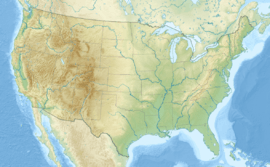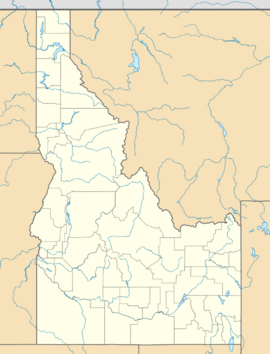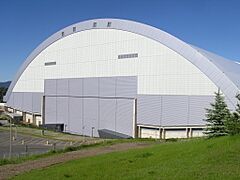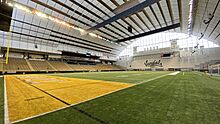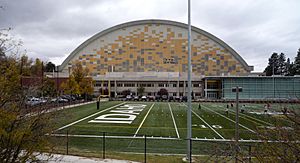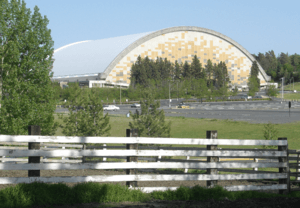Kibbie Dome facts for kids
|
Kibbie Dome
|
|
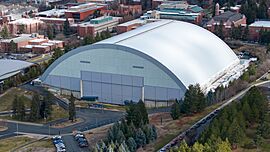
Aerial view from southwest in 2024
|
|
| Former names | Kibbie-ASUI Activity Center (1974–2023) Idaho Stadium (1971–1974) |
|---|---|
| Address | S. Rayburn Street |
| Location | University of Idaho Moscow, Idaho, U.S. |
| Coordinates | 46°43′34″N 117°01′01″W / 46.726°N 117.017°W |
| Elevation | 2,610 ft (795 m) AMSL |
| Owner | University of Idaho |
| Operator | University of Idaho |
| Capacity | Football: 15,250 (2011–present) 16,000 (1971–2010) Basketball: 7,000 (Cowan Spectrum) |
| Record attendance | 19,878 vs. Boise State on November 18, 1989 11,800 – (basketball) vs. Montana on February 12, 1983 |
| Surface | Matrix Turf (2017–present) RealGrass Pro (2007–2016) AstroTurf (1990–2006) Tartan Turf (1972–1989) Natural grass (1971) |
| Construction | |
| Broke ground | February 1971 |
| Opened | September 27, 1975 October 9, 1971 (outdoor) 54 years ago as new "Idaho Stadium" |
| Construction cost | $7.84 million ($42.6 million in 2022 ) |
| Architect | Gene E. Cline of CSHQA Boise, Idaho |
| Main contractors | Emerick Construction Co. Portland, Oregon |
| Tenants | |
| Idaho Vandals (NCAA) (1971–present) | |
The P1FCU Kibbie Dome, often called the Kibbie Dome, is a large indoor sports stadium. It is located on the campus of the University of Idaho in Moscow, Idaho. This stadium is home to the Idaho Vandals sports teams. They play football, tennis, indoor track and field, and soccer here.
For many years, basketball games were also played in the Kibbie Dome. However, a new arena, the Idaho Central Credit Union Arena (ICCU Arena), opened in 2021. Now, basketball games are held there.
The Kibbie Dome first opened in October 1971 as an outdoor football stadium. It was built where the old wooden Neale Stadium used to be. After the 1974 football season, a special arched roof and walls were added. This turned the stadium into an enclosed building. It reopened as an indoor facility in September 1975.
The stadium has 15,250 seats for football games. It was once one of the smallest stadiums for its division of college football. In June 2023, a company called Potlatch No. 1 Financial Credit Union bought the naming rights for the stadium. This means the stadium now includes "P1FCU" in its official name.
Contents
Building the Kibbie Dome
How the Stadium Was Built
The Kibbie Dome was built in different steps over several years. The original plan was for a large outdoor football stadium. It would have had over 23,000 seats. There was also a plan for a separate indoor arena for basketball.
However, due to budget changes, the plans were changed. The new idea was to build a smaller football stadium that could be covered. This way, it could also be used for basketball, indoor track, and tennis. This multi-purpose idea was similar to the ICCU Dome (then called the Minidome) at Idaho State University.
Construction on the concrete stands began in February 1971. This happened after a fire destroyed the old Neale Stadium in November 1969. The old stadium had been unsafe for a while. For two seasons, the Vandal football team played their home games at WSU's field nearby.
The new "Idaho Stadium" opened on October 9, 1971. The Vandals won their first game there 40–3 against Idaho State. This was the first football game on campus in almost three years. For its first four seasons (1971–1974), the stadium was outdoors and had no lights.
In the summer of 1972, a special Tartan Turf field was installed. This was a new type of artificial grass. In November 1974, the university decided to enclose the stadium. The arched roof and walls were finished in time for the 1975 season. The stadium became fully enclosed on September 27, 1975.
Naming the Stadium
The enclosed stadium was renamed the Kibbie Dome in 1975. It was named after William H. Kibbie, a construction executive. He gave a large donation to help fund the project. Mr. Kibbie was a former student of the University of Idaho. The "ASUI" part of its former name, Kibbie-ASUI Activity Center, stands for the "Associated Students of the University of Idaho." This is the student government at the university.
The company that built the roof, Trus Joist Company, used engineered wood products. This was a new idea at the time. The roof project took only ten months to complete. In 1976, the Kibbie Dome roof won an award for its engineering design.
Stadium Upgrades Over Time
After the stadium was enclosed, a special Tartan surface was added in January 1976. This allowed for indoor track and field events. The first basketball game was played on January 21, 1976.
The Kibbie Dome's roof is very wide, spanning 400 feet from sideline to sideline. Its highest point is 150 feet above the field.
Over the years, the roof had some problems with leaks. In 1982, a second roof was built over the original one. This solved the leaking issues. This new roof was built at the same time as the East End Addition.
Football at the Dome
The Kibbie Dome is a key place for Vandals football. It can hold about 15,250 fans for games. A record 19,878 people once watched a game against Boise State in November 1989.
The football field runs in an unusual east–west direction. However, new clear walls added in 2009 and 2011 help with visibility.
The playing surface has changed over the years. In 1990, the original Tartan Turf was replaced with AstroTurf. In 2007, the AstroTurf was updated to RealGrass Pro, a newer type of artificial turf. This turf is made of sections that can be removed.
Major safety upgrades began in 2009. The west wall was replaced with new materials. The east wall was also replaced in 2011. These changes improved safety and made the stadium better for fans. A new press box was built, and a special seating area called the Bud & June Ford Clubroom was added. In 2022, new LED lights were installed, making the stadium brighter.
When there isn't a football game, the artificial turf field can be rolled up. This reveals a large polyurethane surface. This surface is used for indoor tennis and track and field events. It has a five-lane track and lines for nine tennis courts. Basketball and volleyball courts are also marked on this surface.
Basketball at the Dome
The Kibbie Dome also served as the home for the Vandal basketball teams. It offered more seats than the older Memorial Gym. The basketball court was set up in the middle of the field.
The first basketball game was played on January 21, 1976. The court was originally a hard rubber surface. In 1984, it was replaced with a traditional hardwood floor.
From 2000 until 2021, the basketball setup was called the Cowan Spectrum. It was named after Bob and Jan Cowan, who helped fund the basketball area. Large black curtains were used to make the court feel more private. This created a "stadium-within-a-stadium" feel with 7,000 seats.
The Vandals had a great basketball record here. From January 1980 to February 1983, they won 43 home games in a row. A record 11,800 fans watched the streak end against Montana.
In October 2021, the new Idaho Central Credit Union Arena opened. It is now the home for both men's and women's basketball.
Stadium Additions
Since the Kibbie Dome was enclosed in 1975, several important additions have been made. The East End Addition was finished in 1982. This part of the building gave the athletic department new locker rooms, offices, a weight room, and training facilities. Before this, teams had to walk from the Memorial Gym to the Dome.
In 2004, the Vandal Athletic Center was added. This center includes a speed and strength training area. It also has renovated locker rooms and a modern hydrotherapy pool.
Practice Fields Nearby
In August 2005, new SprinTurf fields were installed east of the Kibbie Dome. These artificial grass fields can be used all year round by students and teams. Before, the natural grass fields could only be used for a few hundred hours a year. Now, they can be used for up to 2,000 hours annually.
There are two 75-yard fields, perfect for football, soccer, and other sports practices. They are also used for student intramural games. These fields were updated in 2021 with a new AstroTurf playing surface.
Other Facilities Around the Dome
On the west side of the Kibbie Dome is the Dan O'Brien outdoor track and field stadium. It was named in 1996 after the Olympic gold medalist Dan O'Brien. This stadium has a concrete grandstand that seats 1,000 people.
South of the Dome is the university's 18-hole golf course. It's a challenging course with rolling hills. To the east, you'll find the Memorial Gymnasium (built in 1928), the swim center, and tennis courts. The new ICCU Arena is right to the north of the Dome.
Further north, there are large natural grass fields for intramural sports. This area also includes the women's soccer field and Guy Wicks Field, which was once the baseball field.


